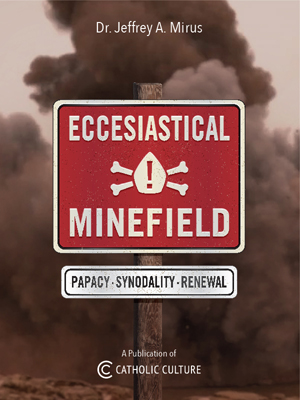Catholic Dictionary
Find accurate definitions of over 5,000 Catholic terms and phrases (including abbreviations). Based on Fr. John Hardon's Modern Catholic Dictionary, © Eternal Life. Used with permission.
Random Term from the Dictionary:
BASILICA
A lengthy oblong religious edifice, rectangular in shape with an apse at one end. This name was originally given to certain ancient churches in Rome, the Holy Land, and elsewhere that were converted from pagan edifices to Christian use. The width of a basilica building is never greater than one half of its length. It is divided by rows of columns into a central nave and a surrounding aisle, or ambulatory. The upper part of the nave is lighted by clerestory windows over looking the roof over the aisles. Similar lower windows light the aisle sections. The altar is placed within or before the apse arching from the nave and opening into the transept, or cross hall. At the main entrance to the basilica is the narthex, beyond which the early neophytes were not admitted. St. John Lateran, the Mother Church, is the archbasilica for the patriarch of the West, the Pope; St. Peter's for the patriarch of Constantinople; St. Paul's Outside the Walls for the patriarch of Alexandria; St. Mary Major for the patriarch of Antioch; St. Lawrence Outside the Walls, for the patriarch of Jerusalem. Each of these major basilicas has an altar exclusively for the Pope's use, and by others only with his permission. Adjoining their basilicas were the former residences of the various patriarchs when they were in Rome. St. Francis of Assisi's church is also a major basilica with a papal altar and a throne. Eleven churches in Rome and many others throughout the world have been designated by the Pope as minor basilicas, e.g., at Loreto and Padua in Italy, Lourdes in France, Lough Derg in Ireland. The clergy who serve in them enjoy a title of honor that gives them certain ceremonial rites. (Etym. Latin basilicus, royal.)







